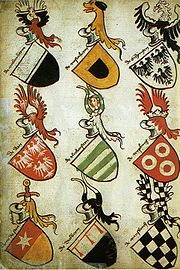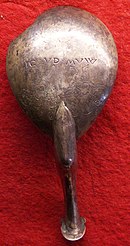
Dahn is a municipality in the Südwestpfalz district, in Rhineland-Palatinate, Germany. It is situated in the Palatinate Forest, approximately 15 km southeast of Pirmasens, and 25 km west of Landau. It is part of the Verbandsgemeinde of Dahner Felsenland.
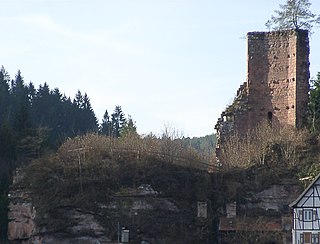
Elmstein Castle is a castle ruin built in the High Middle Ages overlooking Elmstein in the Palatinate Forest in the German state of Rhineland-Palatinate. It was built in the 12th century.
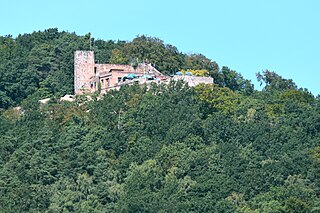
The Rietburg is a ruined hillside castle on the edge of the Palatinate Forest above the village of Rhodt in the county of Südliche Weinstrasse in the German state of Rhineland-Palatinate.

Altdahn Castle is a castle ruin in the Palatinate Forest, the German part of the Wasgau region. It is located near the town of Dahn in Rhineland-Palatinate, Germany. It stands 337 metres (1,106 ft) above sea level (NN).

Spangenberg Castle is the partially rebuilt ruin of a rock castle in the German state of Rhineland-Palatinate. It lies in the Palatine Forest above the Elmstein valley near the village of Erfenstein, but is actually on the forest estates belong to the town of Neustadt an der Weinstraße, or more precisely, the village of Lachen-Speyerdorf. Together with the neighbouring castle of Erfenstein, it is linked to the legend of the Leather Bridge.

The castles of Dahn, near the little town of Dahn in the German state of Rhineland-Palatinate, consist of three rock castles:

Grafendahn Castle lies in the southern Palatine Forest, the German part of the Wasgau region, just under 1 kilometre east of the small town of Dahn in the state of Rhineland-Palatinate.

Tanstein Castle is the ruin of a rock castle in the southern Palatine Forest, the German part of the Wasgau region. It lies just under a kilometre east of the small town of Dahn in the state of Rhineland-Palatinate.

The rock castle of Neudahn, in the southwestern Palatine Forest in the German state of Rhineland-Palatinate, is located at the northern end of an elongated ridge near the town of Dahn. The heart of the castle is situated on one of the sandstone rock outcrops that are typical of the Dahner Felsenland region.
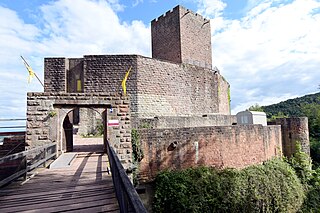
Landeck Castle is a ruined hill castle southwest of Landau, near Klingenmünster in the county of Südliche Weinstraße in the German state of Rhineland-Palatinate.

Erfenstein Castle is a medieval spur castle in the German state of Rhineland-Palatinate. It lies within the Palatine Forest above the Elmstein Valley at 265 m above sea level (NN) in the vicinity of the hamlet of Erfenstein in the municipality of Esthal. Together with nearby Spangenberg Castle, it is linked to the legend of the Leather Bridge.
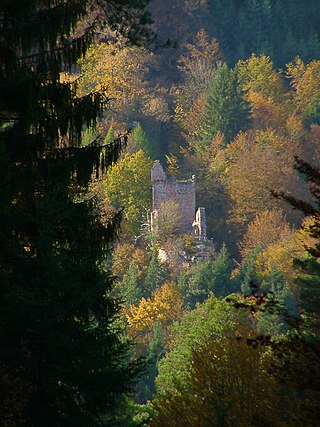
The ruins of Breitenstein Castle stand on a crag, 220 metres (720 ft) high, on the northern side of the Speyerbach valley in the Palatine Forest in Germany. The castles is 4 kilometres (2.5 mi) east of the village of Elmstein in the county of Bad Dürkheim in the state of Rhineland-Palatinate.

Guttenberg Castle is a ruined rock castle near the French border in the German part of the Wasgau, which in turn is part of the Palatine Forest in the state of Rhineland-Palatinate.

Lindelbrunn Castle is the medieval ruin of a rock castle near the village of Vorderweidenthal in the county of Südliche Weinstraße in the German state of Rhineland-Palatinate.
Conrad IV of Tann, also "of Thann" or "of Dahn", was the 48th Bishop of Speyer, holding office from 1233 to 1236.

Schloss Schöneck is a castle which stands on a rock outcrop in the Ehrbach Gorge in the borough of Boppard in the Hunsrück mountains of Germany.

The Ehrenburg is the ruin of a spur castle at 230 m above sea level (NN) in the vicinity of Brodenbach in Germany. The castle had a very eventful history. It was built on a rocky spur called the Ehrenberg situated above the valley of the Ehrbach, a right bank valley of the Moselle. Once the fortified heart of a small imperial barony with estates between the Lower Moselle and Middle Rhine, it is today a cultural monument that hosts numerous events.
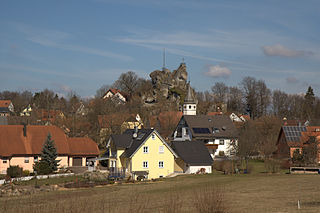
Wichsenstein Castle was a hill castle, once owned by noblemen, on a steep and prominent rock reef (Felsriff) outcrop above the church village of Wichsenstein in the Upper Franconian county of Forchheim in Bavaria, Germany. The castle has been completely demolished and there are no visible remains. The castle rock is now just used as a viewing point.

Old Wolfstein Castle, is a ruined hillside castle on the eastern slopes of the Königsberg at the narrowest point in the Lauter valley near Wolfstein in the county of Kusel in the German state of Rhineland-Palatinate.

